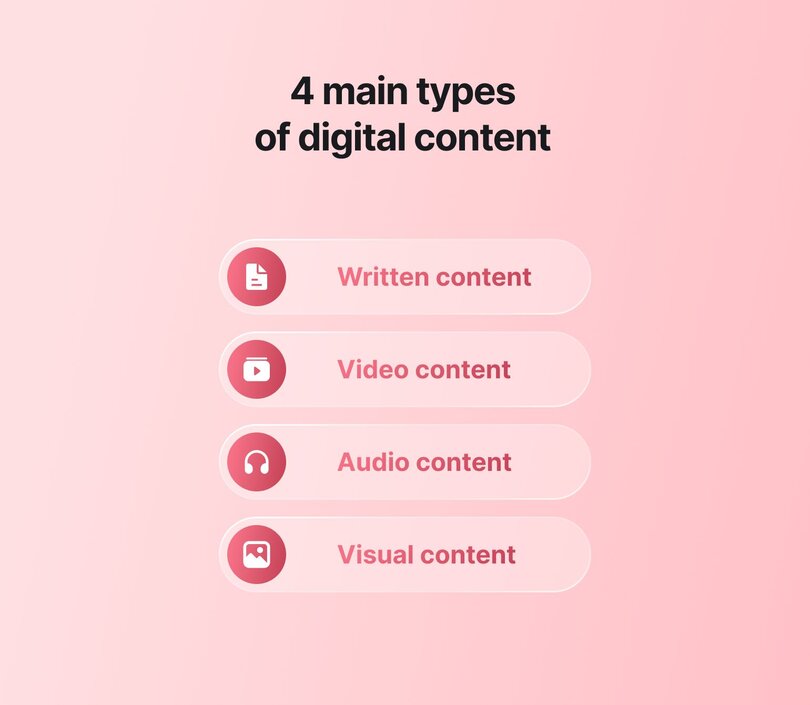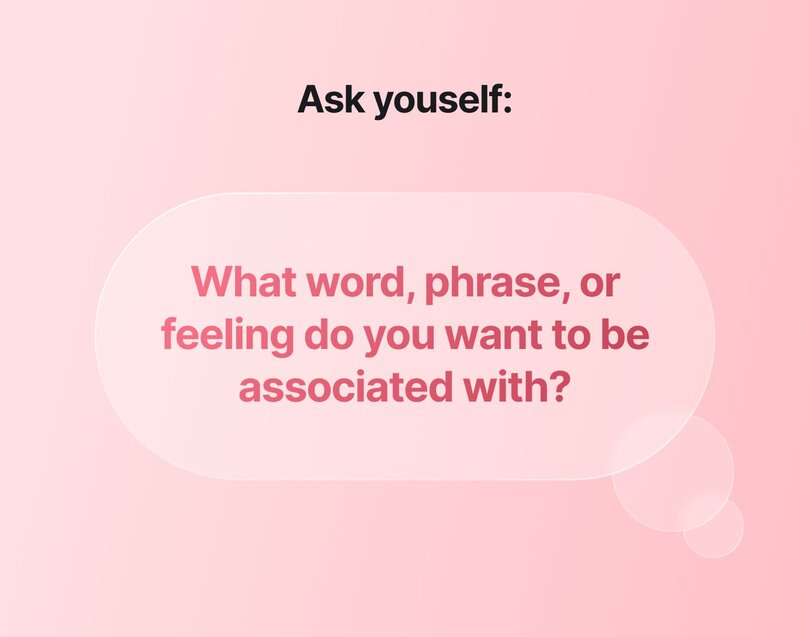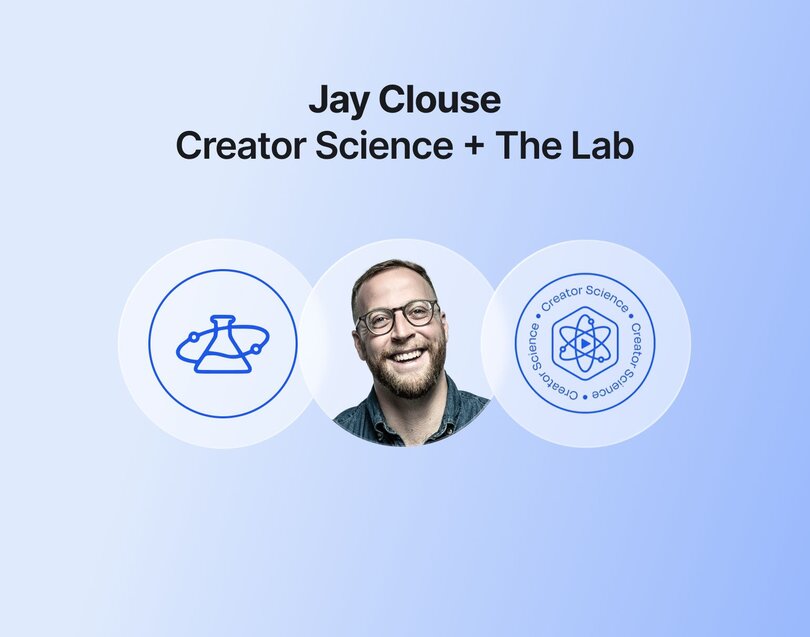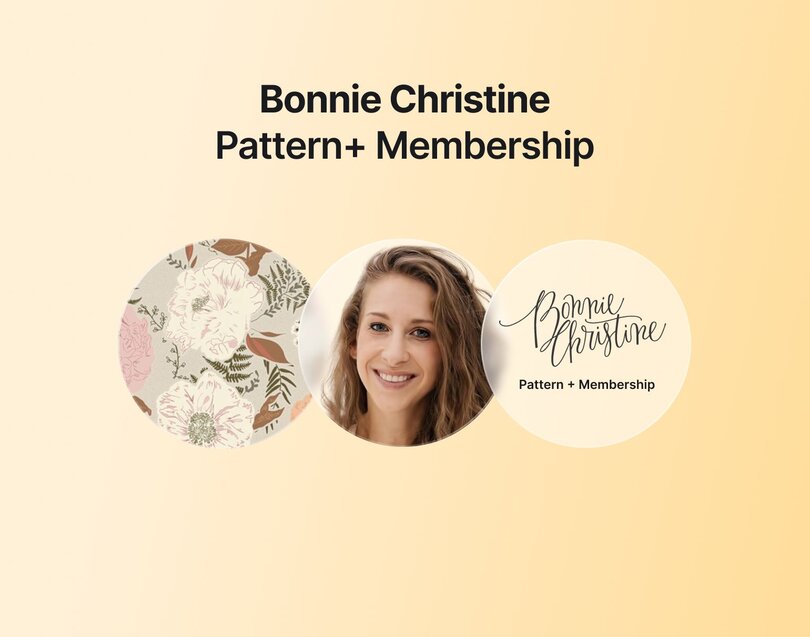Build an unmistakable digital creator brand in 2025
Today’s creator-focused culture may seem like something brand new and even revolutionary, but it’s really an evolution of how people have been creating community around a shared passion for generations.
Before social media gave creators access to potentially billions of audience members, they were making zines in their school art shops or starting bands in their garages.
Fast forward to today, and these digital creators have a seemingly never-ending list of tools and apps to create content and build community.
But it’s not just the tools.
Digital creators blend storytelling savvy with business smarts to turn their connections into a brand and business. Grab your favorite beverage and come along for a ride where we’ll show you how they do it—and how you can, too.
Here’s what you’re going to learn:
- The ABCs of being a digital creator
- 3 key parts of moving from personal to business branding
- Why branding is more than a logo
- Real-life examples from top digital creators
What is a digital creator?
Content creators and digital creators both produce engaging online content, from videos and podcasts to courses and communities.
The difference?
- Content creators focus on creating informative, value-driven content and compelling storytelling.
- Digital creators take it a step further by building entire digital ecosystems and products and businesses around their personal brand.
- Influencers build relationships with their audiences and often partner with brands (DM to partner!) to promote products or services.
👉🏼 All digital creators are content creators, but not all content creators are digital creators.
- A content creator makes content.
- A digital creator builds a digital business with content at its core.
4 main types of digital content
Content can sometimes seem like a big bucket. Thankfully, you can break that bucket down into four main types of digital content.

📝 Written content
Started from the humble blog, now we’re here. 🎶 Digital creators can build their community through newsletters, social media posts, ebooks, and more.
Ideal for: Written content is perfect for people who enjoy writing, editing, and simplifying complex concepts into easy-to-understand content (like this article!)
📹 Video content
From long-form videos on YouTube or Vimeo to short, attention-grabbing TikToks and Reels, great video content connects and informs.
Ideal for: Video content is great for people who are comfortable (or willing to get comfortable) in front of the camera.
📣 Audio content
Podcasts and other audio-first formats let digital creators share deep dives, interviews, and storytelling without needing to be on camera.
Ideal for: Audio content is ideal for those who love great conversations, have a clear voice (or are willing to find theirs), and want to connect with listeners on the go.
🎨Visual content
Looks do matter, especially when it comes to content that stops the scroll. Infographics, carousels, and polished PDFs help digital creators present complex ideas with eye-catching design.
Ideal for: Visual content is perfect for creators who enjoy playing with layout, colour, and clarity, whether they’re using Adobe Express, Canva, or just a good old pen and paper.
How you package these together into your digital creator brand is what makes you stand out. Whether it’s words, visuals, video, or audio, your unique mix is what turns content into connection (and community).
What is digital creator branding (and why it’s not just a logo)
Branding isn’t just picking the right font or designing a sleek logo. It’s the associations your audience makes when they see your name or content.
The same principle applies to digital creator brands. They make sure every piece of content they create represents their brand.
How do they do it?
- They target niche audiences instead of chasing mass appeal
- They prioritize authenticity, consistency, and community engagement
- They maintain a cohesive personal brand across multiple platforms
- They’re intentional with everything they do
👉🏼 Good branding is intentional. It’s the consistent pairing of what you do with what you want to be known for. When done well, it builds trust, creates recognition, and moves people to take action. It’s not magic. It's a repeatable strategy.
Think of some of the digital creators you follow. What describes their brand?
- Habits: James Clear – The author of “Atomic Habits” and has built a brand around how to set (and stick to) habits for success.
- Generosity: MrBeast (Jimmy Donaldson) – From Feastables chocolate bars to virtual restaurants, his consumer-first “Beast Industries” now earns more than his YouTube channel.
- Quality: Marques Brownlee (MKBHD) – His tech-review empire mixes ads, sponsorships, affiliate sales and merch, all built on studio-grade production values.
- Pioneering: Michelle Phan – After co-founding Ipsy, she relaunched EM Cosmetics into a profitable, creator-led beauty line.
Digital creators focus on people, not audiences. They build connections, not just content. That connection is critical to building their business.
It’s not about feeding the algorithm. It’s feeding your future.
🔖 In our 2025 Community Trends Report, 79% of small communities (101–500 members) reported that their community will have a significant impact on their business this year.
When you consistently and intentionally pair your content with the qualities you want to be known for, your audience starts to connect the dots. That’s where trust is built. That’s what helps transform casual interest into meaningful, lasting engagement.
✅ Branding gives people a reason to care and come back.

Bridging the gap: when a creator’s business outgrows the personal brand
A creator brand is built on personality; a corporate brand is built on process. But what happens when a creator’s side-hustle product becomes bigger than the creator?
Think MrBeast → Feastables or Michelle Phan → EM Cosmetics. Each started as a signature “creator line,” then matured into a stand-alone company with its own logo, supply chain, and ops team. At that point, the product needs:
- A distinct visual identity. Not every customer is a follower. The brand needs a distinct identity so buyers who have never watched the creator’s content still recognize it on a shelf.
- Separate brand guidelines. Tone, customer-service voice, and messaging that can be executed by a team, not just the founder.
- Scalable systems. Fulfilment, retail partnerships, and performance marketing that run even when the creator is offline.
Why it matters: Spinning off a dedicated product brand protects the creator’s lifestyle brand while providing the new business with the structure it needs to break into mainstream channels, such as big-box retail or B2B channels.
🍭 The sweet spot? Many modern creators are building hybrid brands by leveraging the authenticity of a creator with the systems and polish of a corporate operation.
How digital creators build brand messaging that connects and converts
Clear brand messaging should make you feel so confident about your offer that you worry more about prospects missing out than about making the sale.
Maya Elious’s five-step “Dating Method” gives creator-community builders a practical checklist to reach that point:
- Narrow your niche. Choose a corner of the “big three” profit pools—health, wealth or self—and drill down until your promise feels unmistakably specific. Think holistic coach who helps people lose weight naturally or career coach for mid-career pros aiming for a $25k raise.
- Define your audience. Your ideal member is either a past version of you or a group you feel called to serve. Look five to seven years back: who were you, what problem were you desperate to solve and who shares that struggle now?
- Position your value. Value is in the eye of the beholder, so frame everything through three lenses:
- What do they need?
- What pain are they living with because they don’t have it?
- What transformation will they experience inside your community, and what’s the cost of never getting there?
- Differentiate your brand. Saturation signals profit, so embrace crowded spaces and stand out through:
- People you target
- Experience level you serve
- An origin story that humanizes the brand
- Proof points such as success rates or revenue milestones
Use this shortened framework as a dating profile for your brand: precise enough to attract the right matches, compelling enough to inspire commitment, and structured enough to scale when your community outgrows you.
Real-life digital creator branding examples (and what you can learn)
It’s one thing to talk about digital creator branding in theory. It’s another to see it in action. These creators have built memorable, community-driven brands by showing up consistently, leading with purpose, and making their audience part of the journey.
Whether you’re just starting or levelling up, there’s something to learn from each of their playbooks.
Pat Flynn

Pat Flynn has built one of the most trusted personal brands in the creator economy by leading with value and consistency. Whether it’s his Smart Passive Income podcast, blog, or community, Flynn’s approach is rooted in a simple philosophy:
“It's not just about getting people to see your content. It's about getting people to come back and trust you. And the way that happens is when you're consistent—not just in schedule, but in message, in values, and how you show up.”
—Pat Flynn, founder of SPI
It’s that service-first mindset that’s helped him build a loyal audience, launch multiple products, and grow a thriving membership community that feels more like a movement than a mailing list.
Jay Clouse

Jay Clouse has designed a system for helping creators become founders. His Creator Science brand is all about sustainable growth and process-driven creativity. At the heart of his work is a clear philosophy:
"Your content attracts. Your newsletter nurtures. Your product converts."
—Jay Clouse, founder of Creator Science and The Lab
By focusing on value at each step of the journey, Jay has built a brand that not only informs, but transforms.
Bonnie Christine

Bonnie Christine’s journey from solopreneur to scaling a thriving creative business is rooted in intentional systems, sustainable growth, and community-first leadership. Her secret? Focusing on the unique mix of talent and passion that only she can bring.
"When you obsess over doing only the things that you can do, your business is going to flourish."
—Bonnie Christine, founder of Pattern+, flowerie, and Pattern Magazine
Her three-phase framework—Dreamer, Doer, Decision—reminds creators that growth isn’t about doing it all, it’s about doing what matters most and building the right team to carry the rest.
There’s a common theme in these examples. If you show up for your audience long enough and deliver consistently, you build something that no algorithm can take away—trust.
Your brand is the invitation to your community
Your brand isn't just how you look or what you say—it's how you make people feel when they show up. It's the handshake, the welcome mat, the open door that determines whether someone steps inside or keeps walking.
Every piece of content, every interaction, every community touchpoint is either rolling out the red carpet or putting up barriers. The difference between brands people follow and brands people belong to comes down to one thing: invitation.
What makes a brand feel like an invitation?
It speaks to shared values, not just shared interests. People might come for the content, but they stay for the connection to something bigger than themselves. When your brand consistently reflects values that resonate—whether that's growth, creativity, authenticity, or rebellion—you're not just attracting an audience, you're calling in your people.
It creates space for contribution, not just consumption. The most magnetic creator brands don't just broadcast—they facilitate. They ask questions that spark conversations. They create opportunities for community members to share their wins, their struggles, and their expertise.
It feels accessible, not aspirational. While inspiration has its place, invitation requires relatability. Your brand should feel like a conversation with someone who gets it, not a lecture from someone who's figured it all out.
Building with your community, not just for them
Start with listening, not launching. Before you decide what your brand stands for, spend time understanding what your community actually needs. Your community will tell you exactly how to position your brand—if you're paying attention.
Make your community part of your story. The strongest creator brands don't just tell their founder's journey—they weave in the stories of the people they serve. Share member wins. Highlight community conversations. Feature the transformations happening inside your space.
Create rituals that reinforce belonging. Whether it's a weekly check-in thread, a monthly community call, or a special way you celebrate milestones, consistent rituals give people something to anticipate and participate in.
Maintaining consistency across all touchpoints
A great brand isn't just what people see—it's what they feel at every touchpoint. Here's how to think about branding across the funnel:
- Discovery: Make sure your voice, visuals, and values show up clearly across your content, socials, landing page, and community home
- Engagement: Keep the connection going with thoughtful touchpoints that reflect what you stand for
- Loyalty: Strengthen trust over time by involving your community and creating space for long-term participation
Keeping your brand consistent with Circle
The challenge with building and managing a custom community tech stack is consistency. Many tools offer customization options, but maintaining a uniform brand across multiple channels can make you feel like a dog chasing its tail.
That’s where Circle comes in, with the tools to create a consistent and cohesive brand experience across every touchpoint. From your content and courses to your events and member spaces, your community gets one seamless experience, and your brand stays front and center, right where it belongs.
Branding mistakes to avoid
Even the most well-intentioned digital creators can trip up when building their brand. Whether it’s trying too hard to look perfect or forgetting to listen to your community, these missteps can slow your growth, or worse, erode trust.
📣The good news? Most branding mistakes are easy to fix once you know what to watch out for.
- Being overly polished or inconsistent. Trying to appear flawless can come off as inauthentic. Inconsistency just confuses your audience. Aim for real and repeatable.
- Prioritizing content over connection. Great content might get the clicks, but real connection is what keeps people coming back. Don’t let the drive for output distract you from the relationships that matter most.
- Building your brand for your audience instead of with your community. Your audience doesn’t just want to follow you, they want to feel part of what you’re building. Remember to make them a core part of your storytelling.
- Blurring the line between personal and professional. You’d think we all learned this lesson, but then you open up LinkedIn. Being open builds trust. Oversharing or having no clear boundaries? That TMI can lead to burnout, bad press, or brand confusion.
- Changing direction without context. Pivots are fine, but take your audience with you. Sudden shifts without explanation can leave your community (and your business) behind.
- Focusing on trends over values. A strong brand is built on clarity and consistency. Trends might seem like an easy way to make a splash, but they can leave your brand soaking wet without a towel—or an audience.
Every digital creator stumbles. What matters is learning, adjusting, and staying rooted in what makes your brand yours. Perfection isn’t the goal. It’s staying intentional and consistent.
9 questions your might have about digital creator branding
Branding as a digital creator isn’t one-size-fits-all, and it’s normal to have questions as you grow.
Whether you’re just starting out or rethinking how your brand connects with your community, here are some of the most common questions creators ask (and the ones you should be asking, too):
Should I use my name or a business name?
Using your name can help build personal connection and trust, especially if you're the face of your brand. A business name might offer more flexibility if you plan to grow a team or expand beyond your personal identity. Choose based on your long-term vision.
How should I brand if I’m multi-passionate?
Being multi-passionate can be an edge when you’re consistent in how you present it. Start by finding a unifying theme or point of view that connects your interests, then let your brand evolve as you do. Your community will follow the why behind your work, not just the what.
How do I brand a community space?
A branded community space should reflect your voice, values, and vibe. Think beyond visuals. Consider how people interact, how they’re welcomed, and what rituals or language shape the space. A strong community brand feels both personal and shared.
When is the right time to rebrand?
Going back to whether you should use your name or a business name, there may be a time when you need to rebrand. This can make sense when your audience, goals, team, or offers change in a meaningful way. If your current brand no longer reflects who you are or how you serve, it’s probably time for a refresh.
What’s the first step of a creator rebrand?
Start with clarity. Revisit your values, mission, and who you’re building for. Then audit your current brand to see what still works and what needs to evolve. From there, you can update your messaging, visuals, and platforms with intent.
How much time should I spend on branding?
Enough to stay consistent, not so much that it becomes a blocker. Branding is ongoing, but it shouldn’t slow down your ability to create, connect, or launch. Start with strong foundations, then refine as you grow.
How do I maintain authenticity while scaling my brand?
Keep your core values and voice front and center. As you scale, invite your community in through co-creation, transparency, and consistent communication. Growth doesn’t have to mean losing your voice—it should amplify it.
What’s the ROI of investing in community branding?
Strong community branding drives trust, loyalty, and word-of-mouth, all of which reduce churn and increase lifetime value. It may not always show up in your first funnel, but it compounds over time. Connection is a growth strategy.
What makes a personal brand community-first?
A community-first personal brand is built with your audience, not just for them. It prioritizes shared values, open dialogue, and spaces for belonging. It’s not just about what you say, it’s about how you make people feel seen, heard, and included.